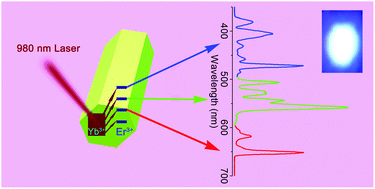Exploiting the silent upconversion emissions from a single β-NaYF4:Yb/Er microcrystal via saturated excitation†
Abstract
Exploiting new transitions in the visible light range is important in the development of advanced color displays, superior laser materials, and novel optical devices. Here, for the first time, we observed several intensive upconversion (UC) emission bands at 382, 472, 506, 560, and 618 nm from a single β-NaYF4:Yb/Er microcrystal via saturated excitation. Compared to the traditional red (650 nm) and green (545 nm) UC emissions, these new emission bands intensify rapidly as the excitation intensity increases, which leads to full-color UC luminescence in the visible region. Nearly white luminescence was elicited from a single microcrystal with a relatively high excitation power. Moreover, the mechanism of these newly observed UC emissions was elucidated by examining the energy migration. It was also found that these microcrystals exhibit waveguide-transmission characteristics and are transparent to their own UC emissions. These findings provide a basis for further exploration of the silent transitions of other rare-earth-ions and demonstrate the potential for using β-NaYF4:Yb/Er microcrystals in a variety of applications in color display and waveguide-based optical devices.



 Please wait while we load your content...
Please wait while we load your content...